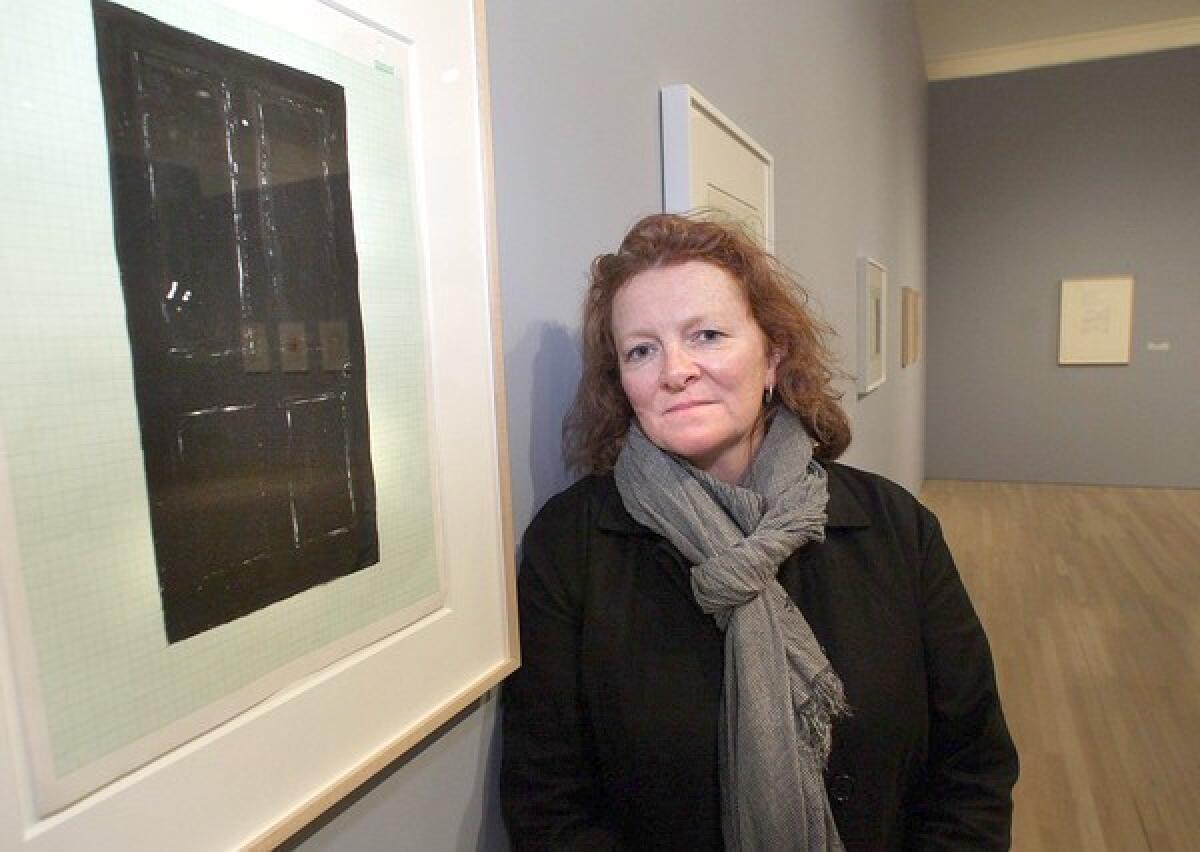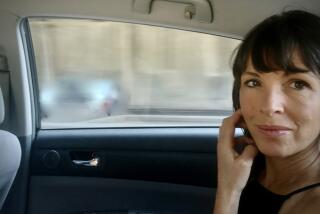Inside Rachel Whiteread’s drawing room

Rachel Whiteread is an artist of big works and big accomplishments.
So what’s going on in “Rachel Whiteread Drawings,” the latest exhibition at the Hammer Museum? The show of 155 drawings, accompanied by eight sculptures and a vitrine of small objects she has made or collected, is the first major museum survey of the artist’s works on paper. It’s also a quietly revealing introduction to the private side of an artist known for monumental public projects.
Way too revealing, Whiteread thought when the show was just beginning to shape up.
“I was very worried about it,” she says at the museum. “At one point, I just felt I was standing in the middle of a room with no clothes on. It made me feel very vulnerable. But I’m feeling much better about it now. I’ve got my clothes back on.” Today they are jeans, dark jacket, fringed scarf and sensible shoes.
Far from the burly, tough-talking type who might be expected to produce her signature projects, Whiteread, 46, is a gentle soul with smiling eyes. And she cheerfully strolls through galleries devoted to themes such as “Tables and Chairs,” “Floors,” “Beds and Mattresses,” “Doors, Windows, Doorknobs and Switches,” “Baths, Plinths and Slabs.”
Collectively, the works offer insight into the sensibility of an artist who’s attracted to ordinary houses and mundane objects but focuses on the spaces in, around and under them.
Part Minimalist, part Conceptualist, Whiteread turns empty space into solid form and transforms domestic objects into public monuments that seem to embody everyday life and human endurance. She emerged, big time, in 1990 with “Ghost,” a plaster cast of the inside of a Victorian living room.
Award-winning ‘House’
Three years later, she replicated the interior of a condemned residence in London’s East End and exhibited it on the leveled site of the original. Simply titled “House,” the massive concrete artwork won Whiteread the 1993 Turner Prize, making her the first woman to be honored by the Tate Britain as the best young British artist of the moment.
Since then, she has represented Britain at the Venice Biennale and turned out one monumental project after another. In 1998, she erected a translucent resin cast of a water tower on a New York rooftop. In 2000, her “Holocaust Memorial” was installed on Judenplatz in Vienna. A tribute to Jews as “people of the book” and a bitter reminder of Nazi book burnings, the concrete structure was conceived as an inverted library. The walls were cast from shelves of books with the pages facing outward.
Commissioned to provide a sculpture for a plinth on London’s Trafalgar Square, Whiteread cast a resin replica of the plinth itself and mounted it upside down as a sort of mirror image. Invited to create a work that would dominate the Tate Modern’s cavernous Turbine Hall, she devised “Embankment,” composed of white polyethylene casts of 14,000 cardboard boxes.
Allegra Pesenti, the curator of UCLA’s Grunwald Center for the Graphic Arts, says the biggest challenge of organizing Whiteread’s show was persuading her to show the drawings. They met in 2007 at a dinner in Rome. Intrigued by a drawing she had come across earlier, Pesenti talked her way into the artist’s studio in London.
“I was a little puzzled,” Whiteread says, “but when Allegra started looking at my drawings, I knew that she really understood them. That was very refreshing.” And Hammer Director Ann Philbin formerly having led the Drawing Center in New York didn’t hurt.
It’s not unusual for sculptors to make and exhibit drawings. Works on paper by David Smith, Gordon Matta-Clark, Robert Smithson and Louise Bourgeois are well known to contemporary art aficionados.
Whiteread, who maintains separate studios for drawing and sculpture in a former London synagogue, treasures her drawings and carefully saves them in cabinet drawers. But when Pesenti arrived, few of them were signed or dated. Though related to her sculpture, the drawings were not conceived as artworks for exhibition. Not as preparatory sketches, either.
Pesenti calls them “very private works” that are “tied to specific memories.” Those memories may be personal, but the drawings are “a place where painting and sculpture meet,” she says, an intimate place that invites outsiders to see thought processes behind the artist’s better known work.
Whiteread, who likens them to a diary, says that “drawing is something I do to worry through a proposal and think about how to do it. It’s not about thinking what the thing will look like.”
“This is about as technical as it gets, thinking about how floor boards will be cast,” she says of a 1995 sheet portraying a grid of rectangles in resin, ink and correction fluid on graph paper. A nearby work relates to a cast iron floor, then in process. “I made a number of drawings of the floor,” she says, “trying to make it materialize because I knew I wouldn’t see the thing finished for three or four months, but it was still on my mind.”
In the “Tables and Chairs” gallery, she points out “One Hundred Spaces,” made in 1995 while she was working on an installation of 100 resin chairs. “I repeated the form and then got a little bit obsessed with it,” she says of rows of nearly identical shapes loosely laid out on graph paper. She loves the softly colored paper “as a background and a scale and a sort of guide to hand-draw reasonably straight lines” but never precisely conforms to its lines.
“I might have a notion about what I’m going to do,” she says, “but then I get another notion. I don’t have fast rules about drawing. It just happens.” In a series of drawings inspired by a herringbone wood floor in a Berlin apartment, where she lived during a scholarship program, she drew two or three boards at various places on the paper and connected them with similar shapes in vibrant compositions that appear to wiggle and squirm into three dimensions.
Honing her talents
Whiteread, born in London in 1963, studied painting at Brighton Polytechnic in Brighton and spent two years working on sculpture at the Slade School of Art in London.
“I started drawing in 1992, during my time in Berlin,” she says, “because I had a wonderful apartment with a fantastic room to work in, a beautifully light room with high ceilings. And it was warm. That meant I could draw without my hands freezing off. The studio I had in London at the time was freezing. You could make sculpture there because you were always standing up and moving around. But sitting down was impossible.”
Currently affiliated with the powerhouse Gagosian gallery and engaged with large commissions she declines to talk about in San Francisco and “in the middle of nowhere” in Norway, Whiteread has moved into a more comfortable lifestyle. Her work continues to evolve, lately including more collage elements in drawings, but it’s all of a piece.
“It’s all about arranging things in space,” she says. With a human touch, though. Often concerned with things bearing evidence of use -- doorknobs, doors, bathtubs, mattresses and furniture -- she talks about “degradation over time,” “the feel of humanness” and “the essence of human.”
Toward the end of the show, Whiteread has installed about 200 objects from her collection on shelves inset in a wall. A bronze swimming cap is the first object she cast. A bunch of twigs are toy guns fashioned by her young son who wasn’t allowed to have toy weapons, so he made his own and stuffed them in his pockets.
The artist has cast her left ear and theater director Peter Sellars’ nose, as well as light switches and the insides of shoes. There are tables and chairs made for a doll house, souvenirs from big projects and fossils she picked up on a walk with her dad. The fossils are like drawings, she says. So is a hank of silky beige cord.
“When Allegra and I were talking about doing the show, she was constantly looking at this stuff that I have in my studio,” Whiteread says. “I think she realized that it was as much to do with my drawing practice as anything else.”
More to Read
The biggest entertainment stories
Get our big stories about Hollywood, film, television, music, arts, culture and more right in your inbox as soon as they publish.
You may occasionally receive promotional content from the Los Angeles Times.










